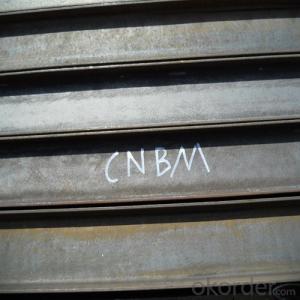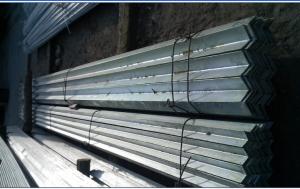Hot Rolled Steel I-Beam IPE IPEAA EN10025 S235JR with Good Price
- Loading Port:
- Tianjin
- Payment Terms:
- TT OR LC
- Min Order Qty:
- 100 m.t.
- Supply Capability:
- 30000 m.t./month
OKorder Service Pledge
OKorder Financial Service
You Might Also Like
Product Description:
Specifications of High Quality Steel I Beam
Standard: EN10025, ASTM, GB Standard, DIN, JIS, etc.
Material of High Quality Steel I Beam:Q235, SS400, A36, S235JR, S275JR, etc
Alloy No. | Grade | C | Mn | S | P | Si |
Q235 | B | 0.12%-0.20% | 0.3%-0.7% | <=0.045% | <=0.045% | <=0.3% |
Sizes: 80MM-270MM
Section | Standard Sectional Dimensions(mm) | ||||
h | b | s | t | Mass Kg/m | |
IPE80 | 80 | 46 | 3.80 | 5.20 | 6.00 |
IPE100 | 100 | 55 | 4.10 | 5.70 | 8.10 |
IPE120 | 120 | 64 | 4.80 | 6.30 | 10.40 |
IPE140 | 140 | 73 | 4.70 | 6.90 | 12.90 |
IPE160 | 160 | 82 | 5.00 | 7.40 | 15.80 |
IPE180 | 180 | 91 | 5.30 | 8.00 | 18.80 |
IPE200 | 200 | 100 | 5.60 | 8.50 | 22.40 |
IPE220 | 220 | 110 | 5.90 | 9.20 | 26.20 |
IPE240 | 240 | 120 | 6.20 | 9.80 | 30.70 |
IPE270 | 270 | 135 | 6.60 | 10.20 | 36.10 |
IPEAA80 | 80 | 46 | 3.20 | 4.20 | 4.95 |
IPEAA100 | 100 | 55 | 3.60 | 4.50 | 6.72 |
IPEAA120 | 120 | 64 | 3.80 | 4.80 | 8.36 |
IPEAA140 | 140 | 73 | 3.80 | 5.20 | 10.05 |
IPEAA160 | 160 | 82 | 4.00 | 5.60 | 12.31 |
IPEAA180 | 180 | 91 | 4.30 | 6.50 | 15.40 |
IPEAA200 | 200 | 100 | 4.50 | 6.70 | 17.95 |
Length: 5.8M, 6M, 9M, 12M or as the requriements of the clients
Descriptions of Metal Structural Steel I-Beam
Grade:SS400,A36,S235JR,S275JR,Q235B. Size:80mm---270mm
1.Origin: Tangshan city . 2.Steel Material :Q195-Q235. ASTM A36, SS400.ect
3.Standard: GB ,JIS ,BS, ASTM, DIN. 4.Size: Meet standard size or as buyer's request .
5.Invoicing on theoretical weight or actual weight as customer request 6.Length: 5.8M, 6M, 8M, 9M, 12M.
Q235B
Chemical composition
Alloy No. | Grade | C | Mn | S | P | Si |
Q235 | B | 1.12%-0.20% | 0.3%-0.7% | <=0.045% | <=0.045 | <=0.3 |
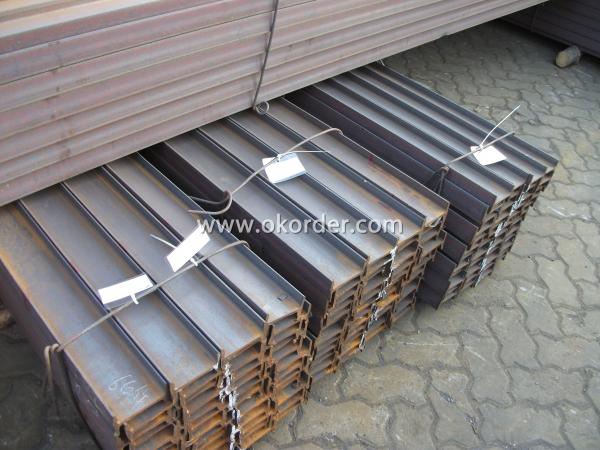
Applications of Metal Structral Steel I-Beam
1.Support structures 2.Pre-engineered buildings 3.Prefabricated structure
4.It is widely used in various building structures and engineering structures such as roof beams, bridges, transmission towers, hoisting machinery and transport machinery, ships, industrial furnaces, reaction tower, container frame and warehouse etc.
Packing & Devilivery of Metal Structual Steel I-Beam
1.Packing: All the metal structural steel I- Beams will be tied by wire rod in bundles and loaded in containers or in bulk cargo. All the bundles will be hung the markings of CNBM, which include the trademark, size, material, length, etc. We can also hang the lables according to the requriements of the customers.
2.Each bundle not more than 3.5MT for bulk vessel; less than 3 MT for container load
3.Tag mark: there will be tag mark tied up on the bundles. The information usually including supplier logo and name, product name, made in China, shipping marks and other information request by the customer. If loading by container the marking is not needed, but we will prepare it as customer request.
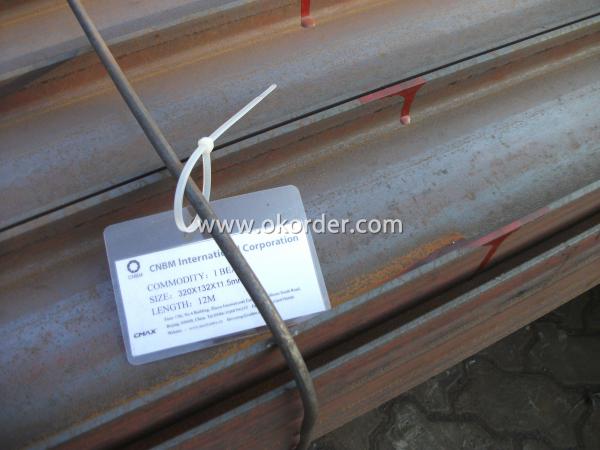
4.Delivery time: Within 30 days after receiving original L/C at sight or deposit by T/T, all the metal structural steel I-Beams will be transported to the port of loading and prepared to load.
5.Transportation: the goods are delivered by truck from mill to loading port, the maximum quantity can be loaded is around 40MTs by each truck. If the order quantity cannot reach the full truck loaded, the transportation cost per ton will be little higher than full load.
Payment terms of Metal Structural Steel I-Beam
1).100% irrevocable L/C at sight. 2).30% T/T prepaid and the balance against the copy of B/L.
3).30% T/T prepaid and the balance against L/C
Others terms of Metal Structural Steel I-Beam
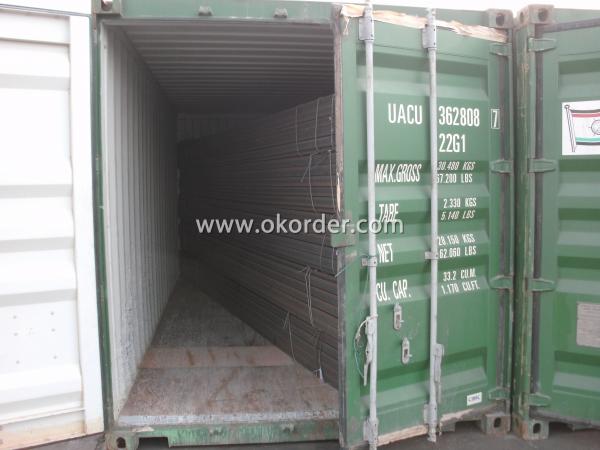
- Q:How do you anchor steel I-beams to the foundation?
- When it comes to anchoring steel I-beams to a foundation, construction commonly employs several methods. One technique frequently used is the utilization of anchor bolts or anchor rods. These bolts or rods are typically embedded into the foundation during its construction. Subsequently, the I-beams are positioned on the foundation, and the flange plates of the beams are drilled to align with the anchor bolt locations. Following this, the beams are fastened to the foundation using nuts and washers, guaranteeing a secure connection. Another approach involves the application of epoxy anchors. To install epoxy anchors, holes are drilled into the foundation, and epoxy resin is injected into these holes. Once the epoxy has solidified, steel rods or threaded rods are inserted into the epoxy-filled holes. The I-beams are then attached to these rods using nuts and washers, creating a sturdy and dependable anchor. In certain instances, welding may be employed to anchor steel I-beams to the foundation. This method entails welding steel plates to the foundation and subsequently welding the I-beams to these plates. Welding offers a permanent and durable connection, but it necessitates skilled welders and proper welding techniques to ensure structural integrity. The choice of a specific method for anchoring steel I-beams to a foundation depends on various factors, including load requirements, foundation type, and construction regulations applicable in the area. It is crucial to consult structural engineers and adhere to local building codes to ensure the correct and safe installation of steel I-beams on a foundation.
- Q:How do you protect steel I-beams from corrosion?
- To protect steel I-beams from corrosion, a common method is to apply a protective coating such as paint or galvanizing. This acts as a barrier between the steel and the corrosive elements in the environment, preventing direct contact and subsequent oxidation. Regular inspections and maintenance are also crucial to identify any coating damages and promptly repair them to ensure long-term protection against corrosion.
- Q:What are the typical applications of steel I-beams?
- Steel I-beams are widely utilized in construction and structural engineering due to their robustness and adaptability. Their strength and versatility make them a popular choice in a variety of applications, including: 1. Construction of buildings: I-beams serve as crucial load-bearing elements in building construction, providing the necessary support and stability to the structure. They are commonly employed in constructing columns, beams, and floor joists. 2. Bridges: Due to their capacity to span long distances and support heavy loads, steel I-beams are frequently employed in bridge construction. They are commonly used as bridge girders, providing the required strength and durability. 3. Industrial structures: In the construction of industrial structures like warehouses, factories, and power plants, steel I-beams play a vital role. They provide the essential structural framework to support heavy machinery, equipment, and storage systems. 4. Mezzanines and platforms: In warehouses and commercial buildings, I-beams are commonly utilized to construct mezzanines and platforms. These provide a sturdy and dependable structure for elevated storage, office spaces, or additional work areas. 5. Architectural designs: Steel I-beams are also employed in architectural designs to create unique and visually striking structures. They can be utilized to create open-concept spaces, cantilevered structures, or dramatic rooflines, enhancing both the aesthetic appeal and structural integrity of the design. In summary, steel I-beams are indispensable components in a multitude of construction projects that require strength, durability, and load-bearing capabilities. Their versatility and capacity to withstand heavy loads make them a favored choice in the construction industry.
- Q:What are the different types of steel reinforcements used in I-beams for renovations?
- I-beam renovations utilize different types of steel reinforcements. These include: 1. Mild Steel Reinforcement: The most common type, known for its strength, durability, and cost-effectiveness. Used when high strength is not necessary. 2. High-Strength Low-Alloy (HSLA) Steel Reinforcement: Offers higher strength and better corrosion resistance than mild steel. Used in structural applications with greater load-bearing capacity or in corrosive environments. 3. Carbon Steel Reinforcement: Contains higher carbon content, enhancing strength and hardness. Used in heavy-duty construction or applications requiring high strength. 4. Stainless Steel Reinforcement: Emphasizes exceptional corrosion resistance. Suitable for coastal or high-humidity areas and applications where aesthetics matter. 5. Galvanized Steel Reinforcement: Coated with zinc to protect against corrosion. Commonly used in outdoor or exposed settings exposed to moisture, chemicals, or harsh weather conditions. It is important to consider load-bearing requirements, environmental conditions, and budget constraints when choosing steel reinforcement for I-beam renovations. Consulting a structural engineer or construction professional is recommended to determine the most suitable reinforcement for a specific project.
- Q:Can steel I-beams be used for seismic retrofitting of existing structures?
- Yes, steel I-beams can be used for seismic retrofitting of existing structures. I-beams are commonly used in seismic retrofitting projects due to their high strength-to-weight ratio and ability to resist lateral forces. They are able to absorb and distribute seismic energy, making them effective in improving the structural integrity and resistance of existing buildings to earthquakes. Steel I-beams can be installed as part of a comprehensive retrofitting strategy that includes other measures such as adding shear walls, bracing, or strengthening existing columns and foundations. However, it is important to note that the specific retrofitting requirements and techniques may vary depending on the building's design, location, and the expected seismic forces that it may encounter. Therefore, it is recommended to consult with structural engineers and experts to ensure the appropriate use of steel I-beams in seismic retrofitting projects.
- Q:How do steel I-beams perform in areas with high salinity or corrosive environments?
- Steel I-beams perform relatively well in areas with high salinity or corrosive environments due to their inherent corrosion resistance. The iron in steel naturally reacts with oxygen and moisture in the air to form iron oxide (rust), which acts as a protective barrier against further corrosion. Additionally, steel I-beams can be further protected through coatings or galvanization processes, which provide an extra layer of defense against corrosive elements. However, prolonged exposure to extreme levels of salinity or corrosive substances may eventually compromise the steel's integrity, requiring regular maintenance and inspections to ensure their long-term performance in such environments.
- Q:Can Steel I-Beams be used for overhead cranes?
- Indeed, Steel I-Beams possess the capability to serve as a suitable choice for overhead cranes. Within the construction industry, these beams are widely employed as integral structural elements due to their remarkable strength and load-bearing potential. Their primary function revolves around delivering support and stability across various applications, including overhead crane systems. To ensure the safe operation of overhead cranes and the successful handling of heavy loads, it is imperative to construct durable and robust support structures. Steel I-Beams are particularly well-suited for this purpose owing to their exceptional strength-to-weight ratio, enabling them to endure the dynamic forces exerted by the crane. The specifics and design of Steel I-Beams for overhead cranes are contingent upon factors such as the crane's weight capacity, the runway's span, and the nature of the load being lifted. Consequently, the beams must be meticulously sized and engineered to cater to the unique requirements of the crane system. Moreover, the seamless connection and integration of Steel I-Beams with other components, including trolleys, hoists, and bridge girders, facilitate the creation of a comprehensive and rigid framework for the overhead crane setup. It is of utmost importance to ensure that the Steel I-Beams employed in overhead cranes meet the necessary standards and codes for structural integrity and safety. Consistent inspections and maintenance procedures must also be carried out to guarantee the continued reliability and optimal performance of the crane system.
- Q:What are the advantages of using steel I-beams?
- There are numerous benefits to utilizing steel I-beams in construction endeavors. To begin with, steel I-beams are renowned for their exceptional strength and durability. They possess a remarkable load-carrying capacity, enabling them to bear heavy loads and endure extreme weather conditions. This renders them suitable for a diverse array of applications, encompassing bridges, buildings, and industrial structures. Moreover, steel I-beams afford design flexibility. They are available in various sizes and shapes, granting engineers and architects the ability to tailor them to the specific requirements of the project. This adaptability simplifies the creation of intricate structures and maximizes the utilization of space. Furthermore, steel I-beams exhibit fire resistance. Owing to their high melting point, they can withstand elevated temperatures more effectively than alternative materials such as wood or concrete. This attribute proves invaluable in terms of safety, as it affords additional time for evacuation and containment in the event of a fire. Additionally, steel I-beams necessitate minimal maintenance. Unlike wood, which is susceptible to rot or pests, steel is impervious to such issues. This translates into long-term cost savings, as regular repairs or replacements become unnecessary. Another advantage of steel I-beams lies in their eco-friendliness. Steel is an extremely recyclable substance, and the utilization of recycled steel in construction projects aids in diminishing the demand for new raw materials and reducing carbon emissions. Additionally, steel I-beams can be easily dismantled and repurposed in other projects, further contributing to sustainability efforts. Finally, steel I-beams confer excellent structural integrity. They possess consistent dimensions and properties, guaranteeing uniformity and dependability throughout the construction process. This renders them the preferred choice for engineers and builders who prioritize safety and stability. In conclusion, the utilization of steel I-beams in construction projects provides numerous advantages, including strength, design flexibility, fire resistance, low maintenance requirements, eco-friendliness, and structural integrity. These qualities establish steel I-beams as a reliable and efficient option for a wide range of construction endeavors.
- Q:Can steel I-beams be used for billboard structures?
- Indeed, billboard structures can employ steel I-beams. The utilization of steel I-beams prevails in construction owing to their robustness and endurance. They exhibit remarkable load-bearing capacities and can endure formidable wind and weather conditions, rendering them apt for bolstering extensive billboards. Moreover, the fabrication and assembly of steel I-beams is effortless, enabling efficient installation and maintenance of billboard structures.
- Q:Can steel I-beams be used for renewable energy projects?
- Yes, steel I-beams can be used for renewable energy projects. These beams are commonly used in the construction of various renewable energy structures such as wind turbines, solar panel installations, and hydroelectric power plants. They provide structural support and stability to these projects, ensuring their longevity and efficiency.
1. Manufacturer Overview |
|
|---|---|
| Location | |
| Year Established | |
| Annual Output Value | |
| Main Markets | |
| Company Certifications | |
2. Manufacturer Certificates |
|
|---|---|
| a) Certification Name | |
| Range | |
| Reference | |
| Validity Period | |
3. Manufacturer Capability |
|
|---|---|
| a)Trade Capacity | |
| Nearest Port | |
| Export Percentage | |
| No.of Employees in Trade Department | |
| Language Spoken: | |
| b)Factory Information | |
| Factory Size: | |
| No. of Production Lines | |
| Contract Manufacturing | |
| Product Price Range | |
Send your message to us
Hot Rolled Steel I-Beam IPE IPEAA EN10025 S235JR with Good Price
- Loading Port:
- Tianjin
- Payment Terms:
- TT OR LC
- Min Order Qty:
- 100 m.t.
- Supply Capability:
- 30000 m.t./month
OKorder Service Pledge
OKorder Financial Service
Similar products
New products
Hot products
Related keywords
